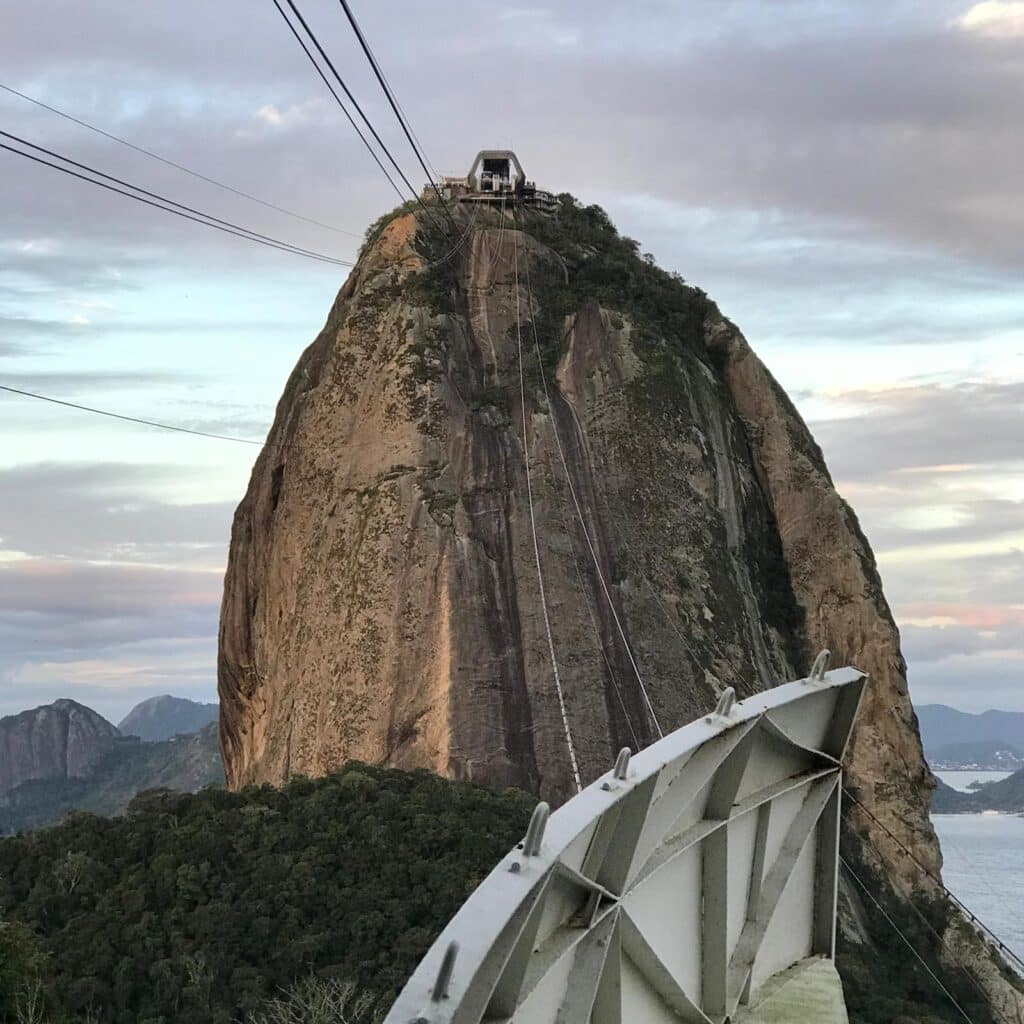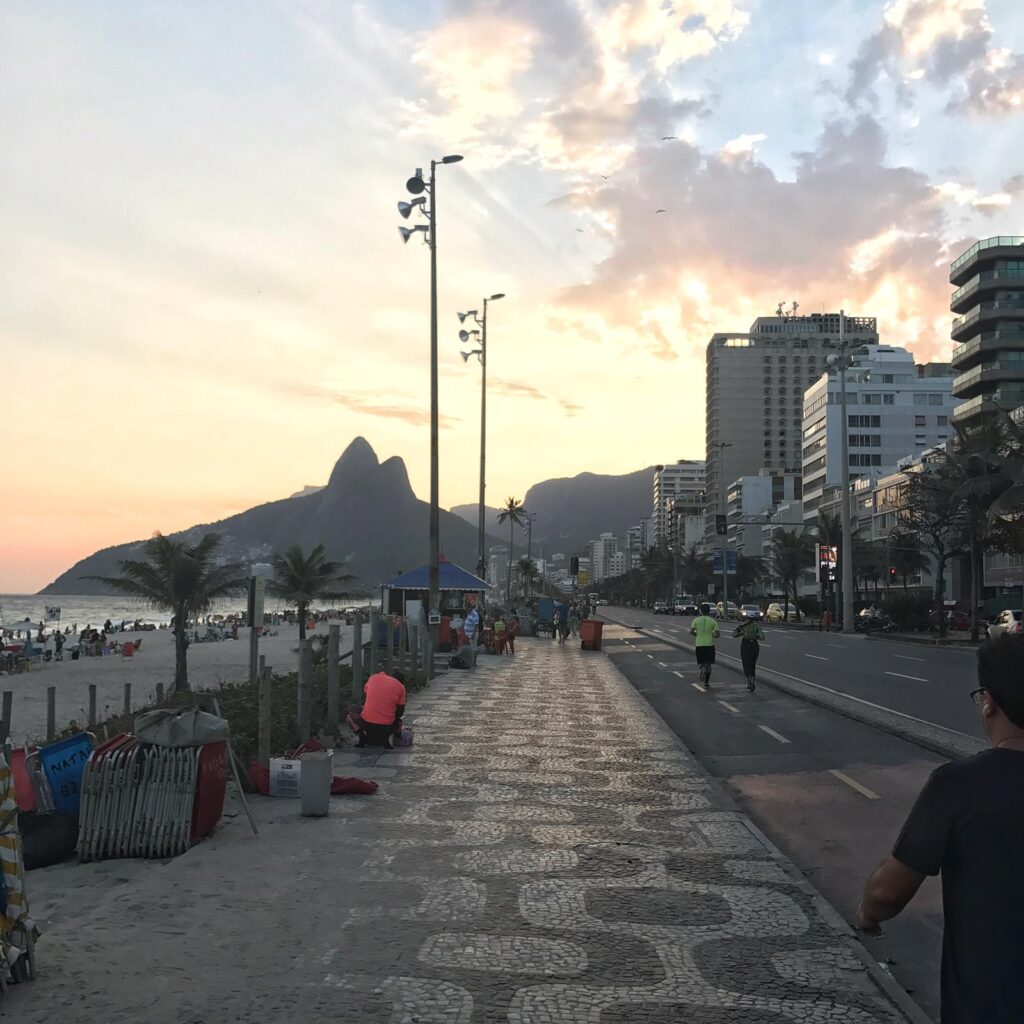Rio de Janeiro is the second-largest city in Brazil. Its nickname is the “Marvelous City“. It is a coastal Brazilian city and one of the most well-known cities in Brazil worldwide.
Famous for its beautiful beaches like Ipanema and Copacabana, and its landmarks such as Cristo Redentor, the Corcovado, and Pão de Açúcar, this city attracts people all over the world with its beautiful landscapes and remarkable sunsets.
The most famous sunset view is Pedra do Arpoador, located between the Ipanema and Copacabana beaches. Still, it is better to get there early and ensure a good place to stay, as it is usually crowded, especially during the peak season. Sightseeing in Rio de Janeiro is a blast, and if you are visiting here for the first time, check out a more extensive Rio Travel Guide.
The city is also known for its Rio Carnival party, with floats, fancy costumes with lots of glitter, and a lot of samba! The New Year is another celebration that gathers thousands of people from everywhere to celebrate and enjoy this incredible place.
If you are coming to Rio for a huge event like this will lots of people and live music, remember to keep safety in mind, like at any big concert or large city you would visit.
There are always shows at the seashore, parties in pubs and nightclubs, celebrations for all tastes and budgets, and loads of fun! Visiting Rio is undoubtedly a fantastic experience for those who like partying.
Don’t forget one of the most famous music festivals of all time: Rock in Rio, which happens every two years, bringing artists from Brazil and all over the world to Rio for a few days with lots of presentations, attractions, and fun.
Getting to know Rio is really a privilege. Imagine if you could know the Wonderful city from the sky. What do I mean by it? I mean seeing the whole city from a helicopter. That’s right! This is an attraction that has amazed Cariocas and tourists.
The Panoramic Flight is a prevalent option for those who visit Rio, allowing tourists to see the city from a different perspective, enjoy the view, and get to know many locations in a completely different and unforgettable way.
All flights follow pre-programmed scripts the company sets, making it easier to choose the places to fly over. You need to look for the available companies, as the cost varies for each option. Price ranges from 650.00 BRL to 5,000.00 BRL, depending on the package.
If you intend to travel to Rio de Janeiro, you need to know a little about its main tourist attractions to visit. Let’s go!
Travel to Rio de Janeiro: Top Things to Visit
1. Cristo Redentor (Christ the Redeemer Statue)
The first thing that comes to mind when thinking about Rio de Janeiro is Cristo Redentor’s image. The Statue of Christ is located on Corcovado Mountain. Elected one of the Seven Wonders of the Modern World, it is also the main postal card of the city.
Situated in the Morro do Corcovado, the famous Cristo Redentor represents Jesus Christ with all its history and meaning. It was said by Pope John Paul II it is “a symbol of love, a call for reconciliation, and an invitation to fraternity”.
Cristo Redentor is a famous worldwide sight attracting around five thousand tourists daily. This giant image of Jesus Christ blessing the city with his arms wide open has become one of Brazil’s main postal cards. As a symbol of Christianity, in 2006, it became a catholic sanctuary. In the following year, 2007, the monument was elected one of the Seven Wonders of the Modern World. It is one of the most famous landmarks and is truly a work of art.
Local tip: The best way to organize yourself is to be one of the first to get to the top, preferably before 8 AM. This is the best time to go. Besides seeing Christ with only a few people around for a while, this is the time of the day when the weather is more pleasant, with lower temperatures, making the program much more enjoyable.
If you prefer to get there in the comfort of a tourist van, buy your tickets in advance and choose the earliest of the day. Do not forget to see the weather forecast, as even if it rains, your ticket won’t be reimbursed and your sight won’t be that great.
2. Pão de Açúcar (Sugarloaf Mountain)

Sugar Loaf Mountain is four hundred meters above the ocean level, the Pão de Açúcar is considered the second most famous place when discussing tourist attractions in Rio de Janeiro. The rock called Pão de Açúcar is West of the Baía de Guanabara (Guanabara Bay), and it reminds the cones that were used to transport sugar to Europe back in time.
The visit starts in the Bondinho, another symbol from Rio. The worldwide famous cable car ride offers a panoramic view of many of the city’s places, beginning at Urca and ending in Niterói. It is pretty easy to get there, but if you are traveling during the holidays, don’t forget to get your tickets in advance on the website.
3. Copacabana Beach (Great Beach, Lots of Outdoor Activities)
Copacabana Beach is a worldwide attraction by itself. It has an amazing tone of blue, with white sand and is always inviting. Signs all along the beach advertise the quality of the water and ensure a safe sea bath.
It is important to always wear sunscreen, as the sun in Copacabana doesn’t take a break! If you like to play or watch beach volleyball, this is the perfect place to do it. There are also many options of food and drinks to buy right in the sand, like the famous yerba mate tea, caipirinha, beer, shrimp, etc.
You can also find all sorts of people from everywhere enjoying the sun and the happiness of the beach vibe. Copacabana is considered one of the most special beaches in the world. It is divided into stations, from the Leme to the Arpoador. You can find many restaurants and kiosks that offer an amazing gastronomic experience for all tastes and pockets.
You can order foods, snacks, beverages, and whole meals while enjoying the sight of Copacabana Beach. Also, you can find, close to Posto 6, almost at the end of the beach, the statue of Carlos Drummond de Andrade, a famous Brazilian writer, and take a classical tourist picture. You can definitely make very special memories in Copacabana!
4. Beaches of Ipanema

“Tall and tan and young and lovely, the girl from Ipanema goes walking…”. It is impossible to visit Ipanema Beach without recalling the famous song from Tom Jobim and Vinícius de Moraes, which was also transposed to English and interpreted by Frank Sinatra.
To roam the two kilometers of beach between the Arpoador and Jardim de Alá, you can rent a bike or simply walk barefoot on the sand by the seashore. And don’t be surprised to find Tom Jobim during your walk. The musician’s statue was inaugurated in 2014 and stays at the beginning of Vieira Souto Avenue, next to Arpoador Beach. The soundtrack is up to a close kiosk, which plays bossa nova and the compositions that immortalized Jobim.
The beach is perfect for enjoying the Atlantic Ocean and diving, walking, or playing sand sports, such as footvolley. Ipanema Beach also draws attention due to the diversity of its visitants.
Local tip: Posto 8 is the closest station to Arpoador Beach and is a point for young people willing to talk and flirt. Posto 9 is the most preferable place for the LGBTQIAP+ community. At the same time, you can find families playing with their children and people from the neighborhood in Posto 10.
5. Santa Teresa Neighborhood
Santa Teresa neighborhood is located in the city center. It is loved by Cariocas and visitors, who love to take pictures on its famous Selarón Staircase (also known as Selarón Steps).
Situated in the heart of the beautiful city, your architectural and natural attractions, like its gazebos, cultural centers, historic buildings, ateliers, restaurants, pubs, hostels, and hotels – and even the Carnival blocks – attract more and more people to this neighborhood, especially those who seek an alternate leisure activity, with a touch of tranquility from the old times, right into the central region of the metropolis.
This is the best area if you want to experience a more local feel.
Santa Teresa has developed throughout the pipes of the old Carioca Aqueduct (Arcos da Lapa). Legend says there’s a history in each corner. Truly, the neighborhood lives up to its fame. It has sheltered intellectuals, writers, musicians, and artists since the middle of the 19th century.
Also, people from the quilombo communities, canonized people, important historical characters, and many elite members who agitated the social life in Rio with their parties that gathered huge names from the literature, music, and all kinds of art from the whole country.
If you wish to enjoy a more intellectual environment that offers pub food and really cold beer, that’s your place to go!
6. Maracanã Stadium (One of the Best Places for Soccer Fans)

For those who like soccer, the Maracanã Stadium is more than a tourist attraction, it’s a historical building. It is a mandatory stop. Even those who live in Rio de Janeiro and are already used to it still manage to visit the stadium with a certain frequency when their teams are playing.
Its beauty and structure are quite interesting, to the point of getting visitors even when there aren’t any games happening, offering incredible touristic and cultural experiences through the Soccer Museum.
Maracanã was the scenery of the most important classic Brazilian soccer games and has lived historical moments of international soccer. Monumental facts, like Pelé’s 1000th goal, in 1969, also happened in this temple of Brazilian soccer.
Launched on June 16, 1950, it has hosted games from FIFA’s World Cup in its inauguration year and some matches of the FIFA’s Club World Cup from 2014. It has also hosted games from FIFA’s Confederations Cup in 2013, opening and closing ceremonies from the Pan-American Games of 2007, and the Olympic and Paralympic Games in 2016.

Besides sportive competitions, Maracanã was a stage of important events, like Maddona, the Rolling Stones, Paul McCartney, and Tina Turner shows, and some masses from Pope John Paul II in 1980 and 1997.
The stadium has also been renovated with a new capacity of 78,838 people. The new Marcanã was renewed, and nowadays, it fulfills all the international requirements of safety, logistics, and sustainability. Over 360 security cameras permanently keep an eye on the stadium, which has received two new access ramps, besides 12 escalators and a total of 17 elevators.
The visits last around 40 minutes and happen daily, from 9 AM to 4 PM, and the price goes from 60 BRL to 120 BRL with a guided tour.
7. Museu do Amanhã (Tomorrow Museum)
The main point of the new Centro do Rio, “Museu do Amanhã” has no collection; it has content. The Tomorrow Museum offers a narrative on how we can live and shape the next 50 years. It is a journey towards possible futures based on the greatest questions humanity has always asked itself.
Driven by ethical values of sustainability and coexistence, essential to the new civilization, the Tomorrow Museum seeks to promote innovation, advertise scientific advancements and publish our planet’s vital signs. A museum to amplify our knowledge and transform our thinking and acting.
Local tip: When visiting there, take at least two hours of your time. If you go with less time available than that, you will only be impressed by the special effects (which are really good). But it is better to take some time to absorb all the information that can be acquired in every room, sphere, cube, pyramid, and cocoon.
8. Jardim Botânico (Botanical Gardens)
Rio de Janeiro’s Botanical Garden is one of the city’s main attractions. It is considered one of the world’s most important and has several interesting attractions. This Japanese garden is where local vegetation is planted for study, maintenance, and preservation.
It is located in the neighborhood that received the same name, Jardim Botânico, in the South Zone of Rio de Janeiro. It is 12 kilometers from downtown, 4.2 kilometers from Lagoa Rodrigo de Freitas, and 1.4 kilometers from Lage Park.
It is a beautiful place and one of Rios amazing natural wonders. The Rio de Janeiro botanical garden has an area of over 500,000 m² of preserved nature. It is a heritage of the National Historical and Artistic Patrimony Institute. Moreover, it is of great value for the country’s history, as it was idealized by Dom João VI in 1808.
In this space, you can find over 40 thousand different plant species. Rare bromeliads and orchids collections can be found there. Visitors can also observe many birds while appreciating this historical patrimony. It is definitely a must-see attraction.
A ticket to visit the Botanical Garden varies according to the profile of the visitors. Brazilian people pay 27 BRL, inhabitants from Rio de Janeiro pay 17 BRL, while foreigners pay 67 BRL. This beautiful park is also accessible via a private tour.
Transport Options in Rio de Janeiro
There are many ways you can do sightseeing in Rio de Janeiro. The city’s geography allows you to choose the best and easier way to move around. It depends on where you are and which places you want to visit during your stay.
Taxi/Cab
Taking a cab and sightseeing in Rio de Janeiro is easy, as they keep looking for passengers. But be careful not to board an illegal taxi at airports and bus stations. The official cabs in Rio de Janeiro are yellow with blue stripes on their sides.
Local tip: always ask for the estimated price before taking a cab, as some taxi drivers may try to trick tourists into paying abusive fees. Don’t fall for fixed-rate offers; pay attention if the driver is not running in circles. Also, be aware that when boarding a cab, there’s a fixed fee for the ride plus the amount calculated by the taximeter according to how long you run. The taximeter can always be seen on top of the car’s frontal panel, and it must also be visible to passengers in the back seat.
Mobile Apps Drivers
Many mobile car ride apps, like Uber, Cabify, 99, and others exist. Uber provides lounges in some areas with a high concentration of people, like airports and shopping malls. This way, passengers and drivers can locate themselves easily and safely. Also, unlike cabs, you can always know the price in advance.
VLT
A favorite among people are sightseeing in Rio de Janeiro who walk around downtown, the VLC is a kind of trolley that has given a new life to an abandoned area of Rio de Janeiro. Now it is a point of encounter for many Cariocas. Besides offering pleasant travel, the VLT has big windows from where you can admire the landscape. It is useful, as it goes through the Santos Dumont airport, Rio de Janeiro’s Bus Station, Tomorrow Museum, Mauá Square, and many other places. The ticket price is 4.30 BRL.
Bike
In the South Zone, you can find bicycles for rent on literally every corner. It is not an exaggeration. There are also many bike lanes in this region, making this option much more pleasant and safe. In the rest of the city, this is still a work in progress, and car drives are not too respectful to bike riders when sharing the same street, so you have to pay attention and be careful.
City Buses
City buses are the most used among the public transportation options in Rio de Janeiro for the locals. This is not the favored option when sightseeing in Rio de Janeiro. Many lines regularly pass (practically every 5 minutes) and cover all the tourist sights. It is also the most cost-efficient option, as a ticket costs only 4.30 BRL.
Local tip: As a tourist do not use the city bus as sometimes they are targeted by petty criminals looking for cash and phones.
Subway
It is one of the best options. Many people from Rio de Janeiro pick this one as their option to move around the city, whether to work and study or for leisure, as it interconnects a huge amount of the city. This is not the best for overall sightseeing in Rio de Janeiro from a tourist standpoint.
A ticket costs 8.15 BRL, and although is not the cheapest option in Rio de Janeiro, it is safe, well-signposted, and reasonably clean. It works from Monday to Saturday, from 5 AM to midnight, and on Sundays and holidays from 7 AM to 11 PM.
General Safety Precautions You Should Take in Rio de Janeiro
Don’t get too impressed by what people say. Although it is common sense Rio can be dangerous, nowadays, tourists who are sightseeing in Rio de Janeiro can walk around Rio with much more security than in the past.
The subway can take you anywhere you want, while the VLT makes it safer to move around the city center, and mobile apps drivers and cabs can pick you up and let you right in front of the doors.
Suppose you walk around Copacabana, Ipanema, or Leblon. In that case, you will notice that more medium-class people are walking on the streets, enjoying the city than in any other Brazilian metropolis.
There are no other places in the country with so many tables on the sidewalks and a street market as strong in medium-class neighborhoods.
If Rio de Janeiro is really that dangerous, why are so many people on the streets?
What happens the most to tourists in Rio is some petty thefts. But that doesn’t happen any more than in any other Brazilian metropolis. In Paris, NYC, São Paulo, Porto Alegre, Fortaleza, etc., walking on lonely streets or using your smartphone and drawing too much attention to yourself late at night, is not advisable.
To enjoy Rio you must get rid of the exaggerated sense of insecurity and fear, and realize that normal life is happening around you. As long as you pay attention to your actions, you will be fine.
Stay safe in Rio by remembering to:
- When sightseeing in Rio de Janeiro, avoid walking on the streets with lots of jewelry, watches, etc.
- Avoid using your smartphone on the sidewalk or in public places like squares
- Take your smartphone in a purse or bag, keeping it on your body, and take it out only while using it
- If you have nothing to carry with you, go out without a purse or bag. The less you can carry, the fewer your worries will be
- Avoid walking on lonely streets, especially at night
- Wait until your cab or mobile app driver arrives to leave the place, do not wait on the sidewalks
- Prefer to take your credit card with you than money, as it is safer and faster to pay
- Enjoy the Wonderful City!
Final Thoughts on Sightseeing in Rio de Janeiro
We covered lots of ways to do your sightseeing in Rio de Janeiro, but the best option will depend on who you are with and your budget.
The best option to move around depends on the places you want to visit and how much you are willing to pay for some extra comfort. Public transportation in Rio is safe unless you draw too much attention to yourself.
Besides the suggested places, there are still many other places worth visiting, with no less spectacular views, like the Baía de Guanabara (Guanabara Bay), Praça Mauá (Mauá Square), Ilha Grande, and some hiking trails and historical buildings located in the Historical City Center, like the Biblioteca Nacional (National Library) one of the biggest libraries in the world and the biggest of Latin America.
Some places like Ilha Grande are not in Rio de Janeiro but are close enough and offer amazing nature trails and beaches.
There are many Rio de Janeiro hotels where you can have fantastic views and many digital nomads like to stay for a while, as Rio is a place you will remember months after travel.
Now that you know much more about Rio, it is time to make your bags and visit this wonderful place!


